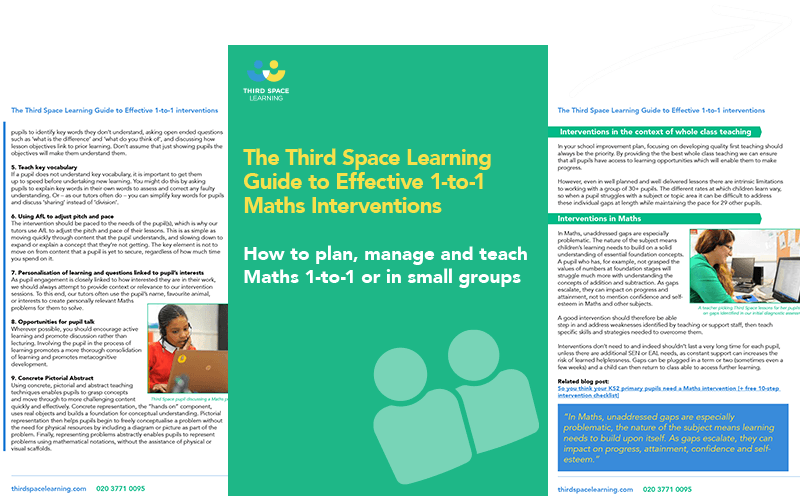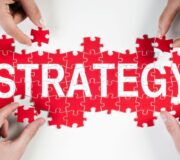Same Day Interventions: How To Keep Up Not Catch Up [KS2]
We all want KS2 pupils to keep up not catch up, in Maths, and many teachers use same day interventions to keep pupils on track. Here’s how to make your same day maths intervention as effective as possible – don’t miss the list of dos and don’ts for success at the end.
Teachers of any year group in the school from Year 1 to Year 6 are tasked with developing pupils understanding in maths and ideally moving them towards mastery of their topics. But progress is neither linear nor standard and pupils will progress differently.
While one pupil may have mastered equivalent fractions and the four operations, another may still require concrete resources to assist him in more basic understanding. This is normal and indeed increasingly prevalent as the majority of teachers now find themselves teaching a mixed ability class.
Your role is to ensure that every child is able to progress at the best pace for them individually and also that they do not get left behind from the learning of the rest of the class.
In addition, as SATs approach, Year 2 Teachers,Year 6 Teachers and SLT become increasingly focused on finding the most effective ways to maximise the learning of the Year 2 and Year 6 children.
Read more: SATs tutoring
Looking at the options
In an effort to support pupils across the school, and especially in Year2 and Year 6, many schools will hold booster classes, lunchtime clubs, after school clubs and even half term lessons! At my school we hold boosters and, when possible, a Maths lunchtime club.
Read more about the different kinds of interventions: Primary School Interventions: What Works At KS1 & KS2
However, this can often lead teachers to feel burnt out.
So if pupils still have gaps in their understanding, we need to look at other ways to increase learning without squeezing all of the energy out of teachers?
The obvious answer is that the teaching workload should be shared among staff across the school and learning especially for SATs shouldn’t start in Year 6…
But it can take time for this culture of collective responsibility to emerge in a school.
Who Should Deliver the Maths Intervention to Year 6?
Obviously the class teacher is in the best option. Yet, due to timetabling conflicts for most schools it would be impossible for them to take the interventions without burnout so who do we look to next?
Intervention Teachers Delivering KS2 Maths Interventions
One option some schools buy into is the the use of intervention teachers.
While there are merits to that solution, I personally worry about the fact this adult hasn’t been in the lesson and does not use the same strategies as the class teacher.
To me, this means there’s a higher chance that children won’t make the connection between class learning and intervention learning as strongly.
External Providers of Math Interventions
Inevitably there will be some pupils in the class for whom a personalised approach is the only way they will really accelerate their progress before any national assessments.
In these cases, 1-to-1 is the best answer and what intervention providers such as Third Space Learning excel at. Diagnostic questions and technology ensures that the questions follow closely what is being done in class. But while affordable, it’s intense and probably only suitable for a third to a quarter of your pupils at most.
So what about the rest of the pupils in your class?
Teaching Assistants Delivering KS2 Maths Interventions
At my school, we believed that that TAs were in the perfect position to deliver Maths interventions at scale to Year 6.
This is because they take part in the actual lesson, learn from the strategies the teacher has used, identify the areas of weakness for the children and watch how the teacher addresses this in the classroom.
They can easily have very good understanding of how an intervention should be delivered to the children.
Take a look at Third Space Learning’s blog post: How The Best Schools Make Use of TAs)
However, despite our positive outlook on using TAs to deliver intervention, research is emerging that shows the flaws in this.
In Rob Webster’s ‘Maximising the Impact of Teaching Assistants,’ I was shocked to find that the evidence suggests the more time a learner spends with a teaching assistant in interventions the less progress they make (this is obviously through no fault of the TA).
My understanding from reading the book is that in terms of the three key aspects of impact – deployment, practice and preparedness – the main changes that need to be made are at a school leadership level.
Delivering Great Maths Interventions: A Same Day Approach
In my school the leadership team had already come to a conclusion…we needed to improve our intervention system, but we had to do this without children missing out on any teaching.
It became clear to us that a same day intervention delivered in the afternoon by a trained TA could be the answer to our problem!
This style of interventions allow children to receive the quality first teaching (which we know is the most effective way for children to make progress) by staying in the classroom during the morning lesson, together with the TA who learns as they do as necessary.
Then pupils catch up with the learning they need more support with (or to consolidate shaky learning) after the lesson.
Training: The SECRET TO MAKING SAME DAY INTERVENTIONS WORK
The new model allows the teaching assistant to receive dedicated and essential training. The observation of good practice in the morning maths lesson not only helps the teaching assistants improve their subject knowledge but also their pedagogy – including style of questioning.
After all, how can manage to develop these skills if they are always out of the classroom when the teacher is teaching?
We also hold TA training sessions while the children are in assemblies in the morning. The aim of this is to embed a consistent approach across the school and ensure that all adults supporting children have a deep understanding of the pedagogy.
I am a huge supporter of training for teaching assistants and so also run a series of subject knowledge training sessions specifically for teaching assistants!
Next year, we have already discussed an extra session to be included about questioning as all of the subject knowledge in the world is useless if it can’t be used alongside a sound pedagogical understanding.
Benefits of the Same Day Intervention Model
We decided to run this same day intervention model through the whole school from the beginning of the last school year.
Since then, we have found that we are starting to close the gaps so that SEN children aren’t being left behind; and so that all children can access learning in the classroom. Our overall goal, in short, is to make sure KS1 and KS2 pupils keep up, not catch up in Maths.
Although the initial data looks promising, we are aware that this will need to be continuously monitored and reflected upon.
With the old intervention model, children we continuously filling gaps in interventions but could never actually catch up with the rest of the class due to the structure of the interventions.
Now, the same day intervention structure allows us to support the children to catch up before the following lesson so that they are not left behind.
Lesson learned from the Keep Up Not Catch up intervention approach
There are still aspects of the model that we need to address.
For example, often, as in our school, same day interventions tend to take place in shared areas. In terms of making effective progress, it isn’t surprising to me that interventions aren’t as effective as they could be!
In the main part, this is because when we take pupils to shared areas for intervention, we remove them from their usual learning environment.
Moreover we actually take them to an area that’s not necessarily made for learning (hallways/desks outside of classrooms/meeting rooms etc.) In this place, there usually isn’t access to learning walls, Maths dictionaries, 100 squares or tens frames for example which would be available in the classroom.
Having changed all of these aspects of their learning, we then still expect them to take the same pride in their learning!
Third Space Learning Guide to Effective 1-to-1 Interventions
How to plan, manage and teach 1-to-1 and small group KS2 Maths interventions to make best use of the resources you have
Download Free Now!How To Implement Same Day Interventions for KS2
If you, as a teacher, would like to start trying this model with your class, I would suggest that you first identify the strengths of your TA. Next, discuss your reflections on lessons with them, to ensure they understand formative assessment and help them build their subject knowledge.
Once you and they feel confident, I would suggest that during a PPA session you deliver a same day intervention focused closely on the skills and knowledge developed in the earlier whole class lesson that day and let them observe how you delivered it.
Finally, take a look at my recommendations for implementing this style of intervention – these are my dos and don’ts. I hope you find them useful.
The Dos and Don’ts of Same Day Interventions For KS2 And Year 6
Do:
• Do hold the interventions soon after the lesson
• Do make sure the teachers have selected the children involved in the intervention
• Do ensure the teachers create the resources for the intervention
• Do find a consistent location for the intervention
• Do ensure TAs use vocabulary and strategies consistent with the teacher
• Do record the impact of the intervention
• Do ensure it is a short, specific and focused intervention
Don’t:
• Don’t have too many children in each intervention
• Don’t take children out of main Maths lessons
• Don’t always take the same children – use assessment for learning during the lesson.
• Don’t see the interventions as a to-do list to get through – reflect on the learning that has taken place
• Don’t expect it to work perfectly straight away!
Same day interventions allow children to feel valued as part of the class, not segregated from it. They can discuss the shared learning with their peers, not feel excluded from it. They can learn through whole class discussion, not be removed from it.
Finally, and most importantly, they allow learners the opportunity to keep up, not catch up!
Read more
DO YOU HAVE STUDENTS WHO NEED MORE SUPPORT IN MATHS?
Every week Third Space Learning’s maths specialist tutors support thousands of students across hundreds of schools with weekly maths intervention programmes designed to plug gaps and boost progress.
Since 2013 these personalised one to one lessons have helped over 150,000 primary and secondary students become more confident, able mathematicians.
Learn how we can teach multiple pupils at once or request a personalised quote for your school to speak to us about your school’s needs and how we can help.





